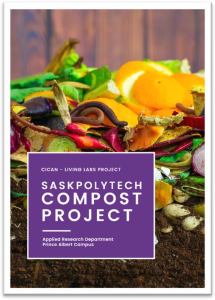Welcome to the On-Site Composting Toolkit for Industrial Facilities and Institutions! In an era marked by increasing environmental consciousness and sustainability goals, the adoption of on-site composting stands as a transformative step toward reducing organic waste, increasing soil health, and fostering a greener future.
This toolkit has been crafted by the Applied Research Department through the Sustainability Led Integrated Center of Excellence at Saskatchewan Polytechnic Prince Albert, Saskatchewan and funded through the Colleges and Institutes of Canada (CICAN).
This toolkit was crafted utilizing the knowledge gained from:
- 2023/24 Saskatchewan Polytechnic Prince Albert Campus On Site Composting Project
- Consultations with Selkirk and Dawson College regarding their Food Waste Diversion projects that utilized a Dehydrator and Vermicomposting systems.
- The knowledge of Keri Sapsford, owner of the Backyard and Compost Corner, who operates a windrow system to Compost for her clients in Prince Albert, and was brought on as a Composting expert to manage this project.
Through this toolkit we hope to promote the use of on site composting at sites where composting services are not available. As Composting can reduce greenhouse gas emissions, divert waste from the landfill and utilize a beneficial nutrient resource that would otherwise go to waste it only makes sense to compost as much as possible. The benefits also expand to those who interact with your site as they become aware of nature-based solutions that will regenerate our land and economy.
A natural process that turns organic material into a nutrient-rich soil amendment. The process involves the decomposition of organic matter by microorganisms like bacteria, fungi, and other decomposers.
Any biodegradable waste material that originates from living organisms or contains organic compounds. This category of waste includes materials that can decompose naturally through the action of microorganisms. Organic waste can be both plant-based and animal-based.
The practice of composting organic materials directly at the location where the waste is generated. Instead of transporting organic waste to an off-site facility or landfill, on-site composting involves creating a composting system within the premises of a residence, business, farm, or institution.
Composting with red wiggler worms in a controlled and enclosed environment to produce a nutrient- rich compost called Vermicast.
In the context of composting, a windrow refers to a long, narrow pile or row of composting materials strategically arranged to facilitate the decomposition process. Windrows are typically formed outdoors and are commonly used in large-scale composting operations.

